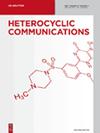有机电化学:21世纪β-内酰胺类化合物的合成与功能化
IF 1.5
3区 化学
Q3 CHEMISTRY, ORGANIC
引用次数: 2
摘要
有机电化学是一种允许非均相氧化还原反应的技术,避免了使用化学计量量的氧化还原试剂和由此产生的化学计量副产物。事实上,这些反应中的氧化还原试剂是电子,它是天然环保的,不会产生副作用。因此很明显,电化学可以被归类为“绿色”技术。利用这种方法合成β-内酰胺并不新鲜,但由于发现了新的应用领域,人们对这类生物活性化合物的兴趣日益浓厚(在由于抗生素耐药性而引起兴趣下降之后),这刺激了人们寻找更有效的电化学方法来合成和转化β-内酰胺。因此,本文综述了21世纪电有机技术在β-内酰胺化学中的应用,首先分析了按反应类型(环化,环加成等)分类的合成方法,然后通过操纵β-内酰胺结构,将其作为合成子使用。最后,这项技术的重要性是通过研究中试工厂规模减少头孢菌酸衍生物的商业上重要的抗生素。本文章由计算机程序翻译,如有差异,请以英文原文为准。
Organic electrochemistry: Synthesis and functionalization of β-lactams in the twenty-first century
Abstract Organic electrochemistry is a technique that allows for the heterogeneous redox reactions avoiding both the use of stoichiometric amounts of redox reagents and the resulting formation of stoichiometric by-products. In fact, the redox reagent in these reactions is the electron, which is naturally eco-friendly and produces no side compounds. It is therefore quite obvious that electrochemistry can be classified as a “green” technology. The use of this methodology in the synthesis of β-lactams is not a novelty, but the growing interest in this class of biologically active compounds, due to the discovery of new fields of application (after a moment of decrease in interest due to antibiotic resistance) has been a stimulus for the search for more efficient electrochemical ways to synthesize and transform β-lactams. Thus, this review deals with the twenty-first-century applications of electroorganic technique to the chemistry of β-lactams, by analyzing first the syntheses classified by the type of reactions (cyclization, cycloaddition, etc.) and then by manipulating the β-lactam structure, using it as a synthon. Lastly, the importance of this technique is demonstrated by a study of a pilot plant scale reduction of a cephalosporanic acid derivative to a commercially important antibiotic.
求助全文
通过发布文献求助,成功后即可免费获取论文全文。
去求助
来源期刊

Heterocyclic Communications
化学-有机化学
CiteScore
3.80
自引率
4.30%
发文量
13
审稿时长
1.4 months
期刊介绍:
Heterocyclic Communications (HC) is a bimonthly, peer-reviewed journal publishing preliminary communications, research articles, and reviews on significant developments in all phases of heterocyclic chemistry, including general synthesis, natural products, computational analysis, considerable biological activity and inorganic ring systems. Clear presentation of experimental and computational data is strongly emphasized. Heterocyclic chemistry is a rapidly growing field. By some estimates original research papers in heterocyclic chemistry have increased to more than 60% of the current organic chemistry literature published. This explosive growth is even greater when considering heterocyclic research published in materials science, physical, biophysical, analytical, bioorganic, pharmaceutical, medicinal and natural products journals. There is a need, therefore, for a journal dedicated explicitly to heterocyclic chemistry and the properties of heterocyclic compounds.
 求助内容:
求助内容: 应助结果提醒方式:
应助结果提醒方式:


